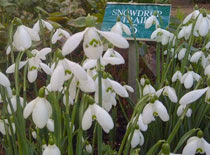I don't know what I was thinking visiting a garden full of perennials in February! Maybe I had a sense that this wasn't a great plan. I didn't even bring a camera because I knew the 3.5 acre medicinal garden wouldn't look anything like it does in pictures like this:
 |
| Chelsea Physic Garden in summer... , www.wikipedia.org |
 |
| Chelsea Physic Garden with the House of Chelsea in the background, www.wikipedia.org |
Snowdrop, Galanthus S. Arnott, http://blog.gardenersworld.com |
ON THE TRAIL
The snowdrops (Galanthus spp) didn't grow in large white carpets as when you find them in a forrest clearing but in neat little bundles like above.
They were set along a Snowdrop Trail that allowed you to compare and contrast the many different kinds of snowdrops as you walked through the garden.
I never knew there were more than 75 species, not all on display, but the surrounding galanthophiles (my new favourite word!) pointed it out and told me that one of my favourites among the snowdrops wasn't even a snowdrop, but 'in the same family'. I see.
A few examples, my two favorites:
 |
| Galanthus Brenda Troyle (I wonder who she was...), http://www.galanthus.co.uk/snowdrop/Brenda-Troyle |
 |
| The snowdrop that isn't a snowdrop but a Spring Snowflake, http://www.life-rostam.de/print/auwaelder-english.htm |
A BIT OF BOTANY BACKGROUND
I thought it would be interesting to join a 1-hour tour done by a volunteer from ‘Friends of the Garden' and it was. I think the garden experts around me also enjoyed it. Here are some highlights:
Chelsea Physics Garden was founded in 1672 as a training ground for apothecaries. Exotic plants and seeds were exchanged through a botanist network that still exists today and explorers such as Captain Cook and Francis Drake brought specimens to Chelsea from their many expeditions.
Cook even took home lava stone from Iceland for the apothecaries’ rock garden, which also consists of rubble from the Tower of London.
Cook even took home lava stone from Iceland for the apothecaries’ rock garden, which also consists of rubble from the Tower of London.
 |
| Sir Hans Sloane in Chelsea Physics Garden, owned the garden,co-founded the British Museum and introduced hot chocolate in the U.K., www.londontown.com |
Today, the garden still maintains over 5000 different species from all over the world for conservation, education and research. This impressive collection includes Britain’s largest outdoor flowering olive tree, beds of perennials and herbs as well as many poisonous plants.
She pointed out the winter flowering clematis and the deadly nightshade that someone apparently felt the need to taste a couple of years back. They spent four days in intensive care.
 |
| Deadly Nightshade, www.wikipedia.org |
On a lighter note: The garden café with the enticing name Tangerine Dream serves breakfast, light lunch and afternoon tea and they do it well - had a really delicious salad.
FIND OUT ABOUT...
Closest tube: Sloane SquareThe Chelsea Physic Garden is open to the public from April 1 to October 31 and for the Snowdrop Days in mid-February. Tuesdays, Wednesdays, Thursdays and Fridays 12-5pm Sundays and Bank Holiday Mondays 12-6pm.
Entrance: Adults: £7, Students and children (5-15 yrs old.) : £5
Chelsea Physics Garden
Snowdrops



No comments:
Post a Comment